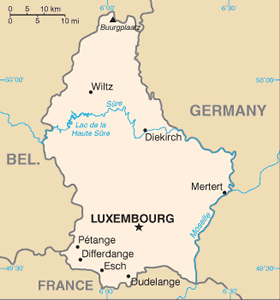The Geography of Luxembourg
The Geography of Luxembourg
Luxembourg Geography
Location: Western Europe, between France and Germany
Geographic coordinates: 49 45 N, 6 10 E
Map references: Europe
Area: total: 2,586 sq km land: 2,586 sq km water: 0 sq km
Area - comparative: slightly smaller than Rhode Island
Land boundaries: total: 359 km border countries: Belgium 148 km, France 73 km, Germany 138 km
Coastline: 0 km (landlocked)
Maritime claims: none (landlocked)
Climate: modified continental with mild winters, cool summers
Terrain: mostly gently rolling uplands with broad, shallow valleys; uplands to slightly mountainous in the north; steep slope down to Moselle flood plain in the southeast
Elevation extremes: lowest point: Moselle River 133 m highest point: Buurgplaatz 559 m
Natural resources: iron ore (no longer exploited), arable land
Land use: arable land: 27.42% permanent crops: 0.69% other: 71.89% (includes Belgium) (2005)
Irrigated land: NA
Natural hazards: NA
Environment - current issues: air and water pollution in urban areas, soil pollution of farmland
Environment - international agreements: party to: Air Pollution, Air Pollution-Nitrogen Oxides, Air Pollution-Persistent Organic Pollutants, Air Pollution-Sulfur 85, Air Pollution-Sulfur 94, Air Pollution-Volatile Organic Compounds, Biodiversity, Climate Change, Climate Change-Kyoto Protocol, Desertification, Endangered Species, Hazardous Wastes, Law of the Sea, Marine Dumping, Ozone Layer Protection, Ship Pollution, Tropical Timber 83, Tropical Timber 94, Wetlands signed, but not ratified: Environmental Modification
Geography - note: landlocked; the only Grand Duchy in the world


